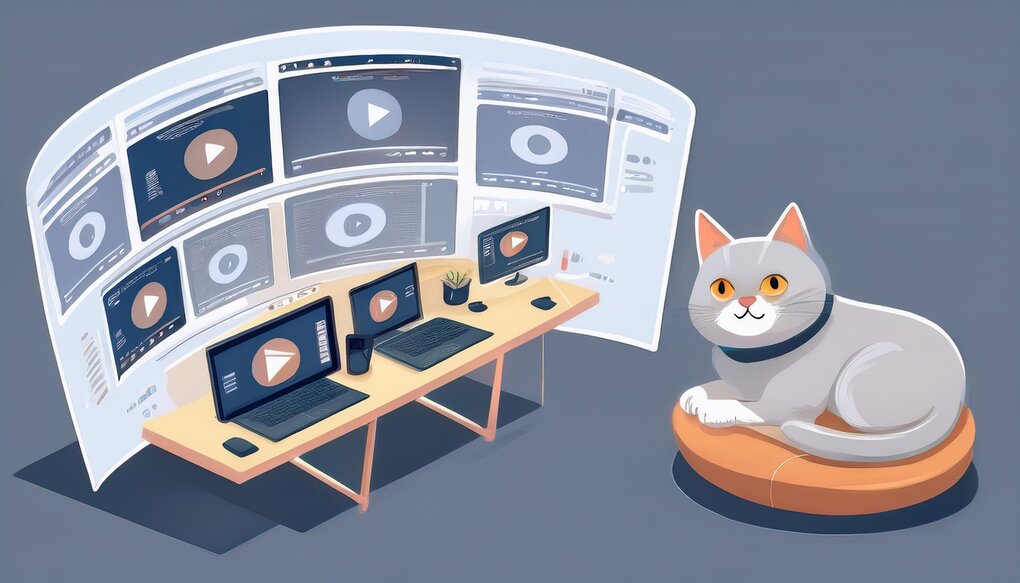
React Player Mastery: Unleash the Power of Video Playback in React
Introduction
In the ever-evolving landscape of web development, integrating rich media content has become a crucial aspect of creating engaging user experiences. React Player emerges as a powerful solution for developers looking to seamlessly incorporate video and audio playback into their React applications. This versatile library supports a wide array of media sources, from popular platforms like YouTube and Vimeo to local file paths, making it an indispensable tool for modern web development.
Features
React Player boasts an impressive set of features that cater to diverse media playback needs:
- Multi-source support: Play media from YouTube, Facebook, Twitch, SoundCloud, Streamable, Vimeo, Wistia, Mixcloud, DailyMotion, and Kaltura.
- Local file playback: Easily integrate video and audio files stored on your server.
- Customizable controls: Create bespoke player interfaces tailored to your application’s design.
- Responsive design: Adapt the player to various screen sizes and devices.
- Lazy loading: Optimize performance by loading player resources on-demand.
- Picture-in-Picture support: Enable PiP mode for supported browsers and file types.
Installation
Getting started with React Player is straightforward. You can install it using npm or yarn:
npm install react-player
# or
yarn add react-player
Basic Usage
Once installed, you can quickly integrate React Player into your application. Here’s a simple example of how to use it:
import React from 'react';
import ReactPlayer from 'react-player';
const VideoPlayer = () => {
return (
<ReactPlayer
url="https://www.youtube.com/watch?v=dQw4w9WgXcQ"
controls={true}
/>
);
};
export default VideoPlayer;
This code snippet will render a YouTube video player with default controls. React Player automatically detects the URL type and loads the appropriate player.
Advanced Usage
Custom Controls
React Player allows you to create custom controls for a more tailored user experience. Here’s an example of how to implement basic custom controls:
import React, { useState, useRef } from 'react';
import ReactPlayer from 'react-player';
const CustomPlayer = () => {
const [playing, setPlaying] = useState(false);
const [volume, setVolume] = useState(0.5);
const playerRef = useRef<ReactPlayer>(null);
const handlePlayPause = () => {
setPlaying(!playing);
};
const handleVolumeChange = (e: React.ChangeEvent<HTMLInputElement>) => {
setVolume(parseFloat(e.target.value));
};
const handleSeek = (e: React.ChangeEvent<HTMLInputElement>) => {
const player = playerRef.current;
if (player) {
player.seekTo(parseFloat(e.target.value), 'fraction');
}
};
return (
<div>
<ReactPlayer
ref={playerRef}
url="https://www.youtube.com/watch?v=dQw4w9WgXcQ"
playing={playing}
volume={volume}
controls={false}
/>
<button onClick={handlePlayPause}>{playing ? 'Pause' : 'Play'}</button>
<input
type="range"
min={0}
max={1}
step={0.1}
value={volume}
onChange={handleVolumeChange}
/>
<input
type="range"
min={0}
max={1}
step={0.01}
onChange={handleSeek}
/>
</div>
);
};
export default CustomPlayer;
This example demonstrates how to create custom play/pause, volume, and seek controls.
Multiple Sources
React Player supports playing content from multiple sources. You can pass an array of URLs to create a playlist:
import React from 'react';
import ReactPlayer from 'react-player';
const PlaylistPlayer = () => {
return (
<ReactPlayer
url={[
'https://www.youtube.com/watch?v=dQw4w9WgXcQ',
'https://vimeo.com/243556536',
'https://soundcloud.com/maddecent/sets/blood-bros-series'
]}
/>
);
};
export default PlaylistPlayer;
Lazy Loading
To optimize performance, especially when dealing with multiple players, you can use the lazy-loaded version of React Player:
import React from 'react';
import ReactPlayer from 'react-player/lazy';
const LazyPlayer = () => {
return (
<ReactPlayer
url="https://www.youtube.com/watch?v=dQw4w9WgXcQ"
controls={true}
/>
);
};
export default LazyPlayer;
This approach ensures that the player resources are only loaded when necessary.
Customization Options
React Player offers extensive customization options through its props and config object. Here are some key customization possibilities:
Styling
You can apply custom styles to the player container:
<ReactPlayer
url="https://www.youtube.com/watch?v=dQw4w9WgXcQ"
width="100%"
height="400px"
style={{ backgroundColor: '#000000' }}
/>
Platform-specific Options
Each supported platform has its own set of configuration options. For example, to customize YouTube player options:
<ReactPlayer
url="https://www.youtube.com/watch?v=dQw4w9WgXcQ"
config={{
youtube: {
playerVars: { showinfo: 1 }
}
}}
/>
Event Handling
React Player provides various callback props for handling player events:
<ReactPlayer
url="https://www.youtube.com/watch?v=dQw4w9WgXcQ"
onReady={() => console.log('Player is ready')}
onStart={() => console.log('Video started playing')}
onPause={() => console.log('Video paused')}
onEnded={() => console.log('Video ended')}
onError={(error) => console.error('Error:', error)}
/>
Responsive Design
Creating a responsive player is crucial for a good user experience across devices. Here’s how you can make React Player responsive:
import React from 'react';
import ReactPlayer from 'react-player';
const ResponsivePlayer = () => {
return (
<div style={{ position: 'relative', paddingTop: '56.25%' }}>
<ReactPlayer
url="https://www.youtube.com/watch?v=dQw4w9WgXcQ"
width="100%"
height="100%"
style={{
position: 'absolute',
top: 0,
left: 0,
}}
/>
</div>
);
};
export default ResponsivePlayer;
This approach maintains a 16:9 aspect ratio while allowing the player to resize based on its container.
Conclusion
React Player stands out as a versatile and powerful solution for integrating media playback into React applications. Its support for multiple sources, customizable controls, and extensive configuration options make it an excellent choice for developers looking to create rich, interactive media experiences.
By leveraging React Player’s features and following the best practices outlined in this guide, you can easily incorporate professional-grade video and audio playback into your React projects. Whether you’re building a simple video player or a complex media-rich application, React Player provides the tools and flexibility to bring your vision to life.
As web technologies continue to evolve, React Player remains a valuable asset in the modern developer’s toolkit, enabling the creation of engaging, media-centric web applications with ease and efficiency.
